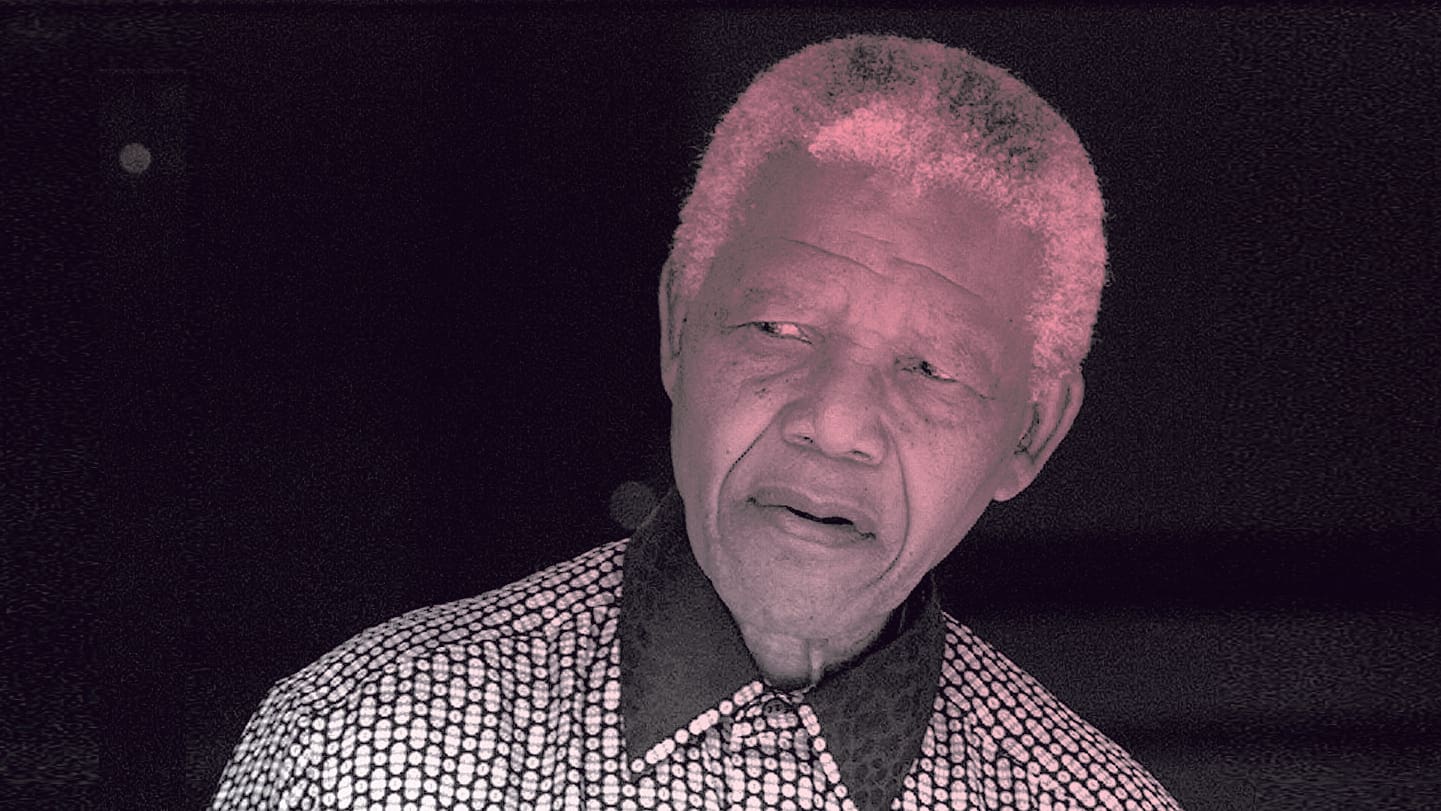Nelson Mandela, a Secret Trust and Money for Margot Honecker
Good and evil are often closer together than one might think – and sometimes, they may even like each other. In the case at hand, a precise reconstruction of events isn’t really possible given that they took place so long ago. But Ismael Ayob, a lawyer from South Africa, remembers one detail precisely: Nelson Mandela – who was president of South Africa at the time and is one of the few people in the world almost universally regarded as "good" – asked him to transfer money to Chile in the 1990s. The recipient was Margot Honecker, known in Germany as the "Purple Witch." After the Berlin Wall fell in 1989, the widow of former East German leader Erich Honecker went to live in exile in Chile. Margot Honecker spent several years as minister of education in Germany and was responsible for the communist state’s practice of forcibly removing children from dissident families for adoption. Most Germans would clearly assign the East German "first lady" to the "evil" camp.
But Nelson Mandela pitied her, Ismael Ayob told the Süddeutsche Zeitung over the phone. "He came to me and said that Margot Honecker was stranded all alone in Chile, without her husband, without money and without a pension. He asked me to send her money." Ayob, who was Mandela’s financial adviser at the time, says he still has vivid memories of the incident because it was such an "unusual request." Honecker, after all, was anything but unknown. Ayob remembers Mandela personally giving him Margot Honecker’s bank account information and the address of the bank in Chile. "He probably just handed me a piece of paper," Ayob says. "He did such things frequently. In any case, there must be something in writing."
The story of this surprising financial connection has surfaced after so many years because of the numerous records in the Paradise Papers that document an extensive legal battle between Ismael Ayob and Nelson Mandela’s estate. Journalists from the South African newspaper Financial Mail discovered the documents shortly before the first stories based on the Paradise Papers were published in early November.
Ayob, now 75, still practices law in a Johannesburg suburb just a stone’s throw from Mandela’s last residence before his death, was long one of the late South African leader’s closest confidants and one of the few people who was allowed to visit Mandela in prison. The two had known each other since the 1970s but had a falling out around 2004. One of the consequences of that falling out is the battle over a bank account with a balance in the millions and a trust fund on the Isle of Man, a tax haven. Though the disagreement begins with the question as to whether the so-called "Mad Trust" even existed as such, whether it was set up properly and whether Ayob really used it in accordance with Mandela’s wishes – or just his own.
The court documents allow for an astonishing look into Mandela’s finances. Ayob says that he wired the money to Margot Honecker from one of the accounts belonging to this trust. However, it could not be verified whether the transfer ever took place. There are no documents pertaining to the transaction in the Paradise Papers trove.
The Nelson Mandela-Margot Honecker connection seems a bit absurd at first. Mandela was one of the most famous and best-loved freedom fighters in the 20th century while Honecker defended the oppressive East German regime until her death in Santiago de Chile in 2016. But it is only contradictory at first glance. In the 1980s, South Africa was one of the theaters of the Cold War, the decades-long proxy battle between the United States and the Soviet Union. Western politicians like U.S. President Ronald Reagan stood solidly at the side of the apartheid regime in South Africa as did other Western leaders – and even conservative politicians in Germany. Several countries on the eastern side of the Iron Curtain, by contrast, supported the South African opposition, led by the African National Congress (ANC). East Germany frequently received ANC delegates and more than 1,000 ANC members even reportedly received military training in the East German town of Teterow between 1976 and 1980.
At the time, Nelson Mandela was behind bars while Margot Honecker and her husband controlled the East German state. But by the 1990s, their roles had essentially reversed. Mandela was released from prison in 1990, oversaw the end of apartheid and became his country’s first black president. Margot Honecker, meanwhile, fled to Chile with her husband after the East German regime collapsed in 1989. Erich Honecker passed away in 1994. According to Roland Jahn, who is the German commissioner responsible for overseeing the records compiled by East Germany’s secret police, the Stasi, Margot Honecker’s re-education and forced adoption policies during her 1963-1989 tenure as education minister, "hurt people’s lives and robbed them of self-determination." Head of the Stasi memorial in the Hohenschönhausen district of Berlin, Hubertus Knabe, says that Honecker was an "evil, hard-hearted women" to the very end.
Mandela, though, didn’t try to hide his displeasure over Hoenecker’s downfall. In a 2013 interview with the Cologne daily Kölner Stadt-Anzeiger, Mandela praised the Germans for their peaceful reunification, but warned: "Though I would still like to recall Margot Honecker, who is living in Chile today in what I hear are miserable circumstances. I don’t want to level charges of insensitivity, but Erich Honecker was a head of state and Margot Honecker was the first lady. And I’m not sure that German leaders are still aware of that fact."
The transfer to Chile may not have been so absurd after all
According to a former East German ambassador, Mandela told an East German delegation on the sidelines of a conference in South Africa that he had collected money from ANC leaders to support the Honeckers in Chile. The alleged money transfer to Margot Honecker in Chile, in other words, wasn’t perhaps all that absurd after all – at least from a domestic policy perspective of South Africa during that period.
According to the Paradise Papers, the trust on the Isle of Man was established on Jan. 21, 1995, just over eight months after Nelson Mandela was sworn in as president of South Africa. Mandela’s financial adviser, Ayob, was apparently responsible for setting it up. According to the roughly 17-page trust deed, the foundation-like structure was to donate funds to individuals and to "educational and charitable objects." The name "Mad Trust" is a reference to the name of Mandela’s traditional clan, Madiba. It is unclear why Ayob chose to establish the trust on the Isle of Man, though the lack of transparency offered by the location may have been attractive. The island had neither a registry of trusts nor a requirement to share information with other countries. As such, the Mad Trust resembled a slush fund in many respects.
Ayob said it was difficult back then to send money from South Africa, making the Isle of Man a practical solution. But Mandela was really only interested in charity, he adds. "Mandela wanted to use the money to quickly send funds here and there, for example a transfer to a young athlete who had won a prize in Switzerland but who wouldn’t have been able to afford the airfare."
By the time Mandela and his long-time financial adviser Ayob fell out in 2004, the South African leader had already left office. And the Mad Trust played a role in the ensuing dispute. An examination of the court documents pertaining to the dispute, it quickly becomes clear that tangible evidence of anything related to the trust is in short supply. Mandela and his wife were registered as donors at the bank where the account was held, though it’s not clear who registered them.
And where did the money for the mysterious trust come from in the first place? Ayob maintained in written testimony that it came from foreign benefactors and had found its way to Mandela during one of his numerous trips abroad. If Ayob’s testimony is true, it would mean Mandela received millions of euros from sources that were problematic in some cases and rather intriguing in others. Ayob claims in his testimony, for example, that a payment of $10 million from the Indian government, $10 million from Oprah Winfrey and another $10 million from the Libyan head of state Moammar Gadhafi. Mandela could use the money as he liked, Ayob testified, adding that the funds went to various foundations, but also to buy homes for Mandela, his children and his grandchildren.
In November 2003, the business consultancy Deloitte audited Mandela’s finances, resulting in doubts arising about the existence of the trust, accounts belonging to which contained around $2 million at the time. On one bank statement, a handwritten note reads: "The owner of this account is Mr. N.R. Mandela. There is no Mad Trust as such and it is only used as a name." Ayob disputes this.
Mandela himself wrote at the time to Ayob to inquire who the trust and its money belonged to. His answer was clear: The trust belonged to Mandela.
Ultimately, the Deloitte auditors likewise treated the account as Mandela’s personal bank account. What’s more: They recommended a voluntary disclosure of tax liabilities, since they had apparently come to the conclusion that the money had never been taxed in South Africa. At the time, the country had a tax amnesty program for remorseful tax evaders.
Mandela’s heirs say the arrangement seems uncharacteristic
The next dispute came after Mandela’s death in late 2013. When the inheritance was examined, the Mad Trust made another appearance. Apparently even some of Mandela’s closest confidants had known nothing about it. His heirs went to court and demanded the trust’s assets, which at the time amounted to 1 million euros and were still being administered by Ayob. They argued the trust had not been properly set up and that as a consequence, the money was part of Mandela’s personal assets. This was also the stance taken by the law firm Appleby, which served as a kind of external consultant. Appleby maintained the trust was flawed because no beneficiaries had been named when it was established. The heirs also claimed that the whole business with the trust was uncharacteristic of Mandela. "I would be very surprised if (Mandela) ever gave instructions to have offshore assets, or was aware he had offshore assets," says Michael Katz, the lawyer who manages the late leader’s estate. It was telling, he adds, that Ayob could prove nothing, neither that he had set up the trust at the behest of Mandela, nor where, when or how Mandela had made the request.
In November 2015, a South African judge ultimately ruled that the money in the trust belonged to Mandela’s estate and that Ayob had no control over it. There are, however, plenty of open questions that remain when it comes to Mandela’s estate, with millions said to be missing.
Ayob’s claims now add a new piece to the puzzle: Exactly how much money did Margot Honecker receive from the account of the mysterious trust on the Isle of Man – if she received any money at all and Ayob didn’t simply make the whole thing up? Absent concrete evidence, even that scenario can’t be ruled out. Ayob told the Süddeutsche Zeitung it was not a large sum – more of a symbolic value, really. It was to make her feel good, to show her she hadn’t been forgotten, he said.
Having passed away 18 months ago, Margot Honecker can no longer shed light on the issue. At the funeral, an East German flag was draped over her coffin and attendees sang "The Internationale" – the anthem of global Socialism. Her daughter Sonja could not be reached for comment.

